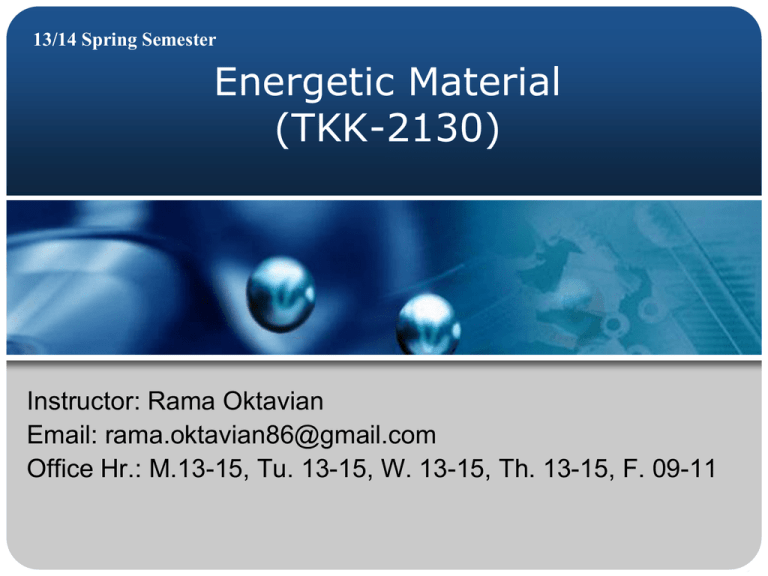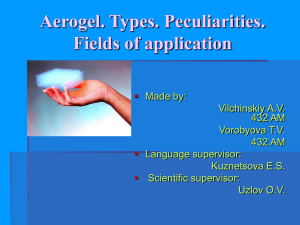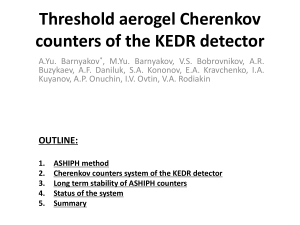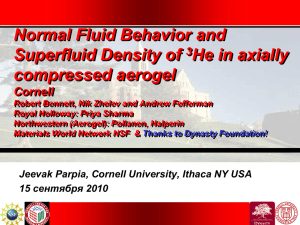What is Aerogel
advertisement

13/14 Spring Semester Energetic Material (TKK-2130) Instructor: Rama Oktavian Email: rama.oktavian86@gmail.com Office Hr.: M.13-15, Tu. 13-15, W. 13-15, Th. 13-15, F. 09-11 Outlines 1. Aerogel 2. Types of Aerogel 3. Aerogel synthesis process 4. Aerogels application 5. Recent status of aerogel Aerogel What is Aerogel ? A classic silica aerogel monolith (image credit Prof. C. Jeffrey Brinker) Aerogel What is Aerogel ? A Nanostructured Material with Fascinating Properties and Unlimited Applications Aerogel What is Aerogel ? • Is essentially the solid framework of a gel • A class of porous, solid materials that exhibit extreme material properties • Aerogels are derived from gels–effectively the solid structure of a wet gel • Aerogels were first created by Samuel Stephens Kistler in 1951 An aerogel is an open-celled, mesoporous, solid foam that is composed of a network of interconnected nanostructures and that exhibits a porosity (non-solid volume) of no less than 50%. Aerogel Aerogel’s properties • extreme low densities (which range from 0.0011 to ~0.5 g cm-3) • Very good thermal insulator • High specific surface area • Lowest dielectric constant Aerogel Aerogel Aerogel is nanotechnology A nanometer is 1 billionth of a meter. A hair is 80,000 nm wide. Aerogel is a glass foam with bubbles 10 nm wide. Aerogel Aerogel What are aerogels made of? • Silica • Most of the transition metal oxides (for example, iron oxide) • Most of the lanthanide and actinide metal oxides (for example, praseodymium oxide) • Several main group metal oxides (for example, tin oxide) • Organic polymers (such as resorcinol-formaldehyde, phenol-formaldehyde, polyacrylates, polystyrenes, polyurethanes, and epoxies) • Biological polymers (such as gelatin, pectin, and agar agar) • Semiconductor nanostructures (such as cadmium selenide quantum dots) • Carbon • Carbon nanotubes, and • Metals (such as copper and gold) Aerogel Silica aerogel • high specific surface area (500–1200 m2/g) • high porosity (80–99.8%) • low density (∼0.003 g/cm3) • high thermal insulation value (0.005 W/mK) • ultra low dielectric constant (k= 1.0–2.0) • low index of refraction (∼1.05) Silica Aerogel Source materials • Water glass • Na2SiO3 • silicon alkoxides (e.g. Si(OMe)4) Precursors Catalyst • Tetramethoxysilane (TMOS) • Tetraethoxysilane (TEOS) • Methyltriethoxysilane (MTES) • Methyltrimethoxysilane (MTMS) • H2O Solvent • Alcohol group • Ionic liquid Silica Aerogel Precursors a starting compound for preparation of a colloid (or sol). • Tetramethoxysilane (TMOS) • Tetraethoxysilane (TEOS) • Methyltriethoxysilane (MTES) • Methyltrimethoxysilane (MTMS) Silica Aerogel Synthesis • Gel preparation • Aging of the gel • Drying of the gel Silica Aerogel Gel preparation • The silica gel is obtained by sol–gel process a process in which solid nanoparticles dispersed in a liquid (a sol) agglomerate together to form a continuous three-dimensional network extending throughout the liquid (a gel). Silica Aerogel Gel preparation • Sol-gel reaction Silica Aerogel Gel preparation • Gelation With time the polycondensation of silicon alkoxide produces colloidal particles that link together to become a 3-D network Silica Aerogel Aging of the gel With time after gelation the solid network immersed in the pore liquor continues to evolve. The gel prepared in the first step is aged in its mother solution. This aging process strengthens the gel. Bulk density and pore size are influenced by concentration aging solution and aging time Silica Aerogel Aging of the gel Polycondensation – reactions continue to increase network Syneresis – spontaneous shrinkage; continues until gel is a solid mass Coarsening –small particles grow initially and act as “nutrients” for bigger crystals Silica Aerogel Factors Affecting Chemistry • H2O/Si Molar Ratios • Temperature and Time • pH • Catalyst Silica Aerogel Drying This is where the liquid within the gel is removed, leaving only the linked aerogel network. • Supercritical drying • Ambient pressure drying • Freeze drying Silica Aerogel Supercritical drying Silica Aerogel Supercritical drying procedure compressing and heating the sol-gel above the critical pressure and temperature of the solvent decompressing it down to atmospheric pressure cooling it down to room temperature Silica Aerogel Supercritical drying procedure for silica aerogel in ethanol sol-gel is placed in the autoclave and charged with additional ethanol the system is then pressurized to at least 5-6 MPa with CO2 and cooled to 5-10°C. Supercritical fluid is flushed through the vessel until ethanol has been totally removed from the vessel and from within the gel. Carbon Aerogel Properties of carbon aerogels Lowest density solid Thermal conductivity of .03 W/m-K Surface area of up to 1200 m2 / g Capacitance of 100-200 F/g Up to 99.9% air Power densities up to 20 kW/kg Energy densities up to 325 kJ/kg Low index of refraction 1/2000 to 1/5000 the size of normal ultra-capacitors Brittle Carbon Aerogel How is it made? Step 1: Organic aerogels – Formed with a formaldehyde solution – Resorcinol is used as catalyst – Dried in methanol for 3-5 days – Super critical CO2 drying Carbon Aerogel How is it made? Step 2: Pyrolysis – Requires an inert gas – Organic aerogel is placed into a furnace at 1100° C – Converts the organic molecules into carbon Aerogel Application Thermal insulation Supercapacitors Filter and absorption media Energy storage Lithium battery (carbon aerogel) Aerogel Application in energy-related sector Source: Vladimir Anikeev,Maohong Fan. 2014. Supercritical fluid for energy and environmental application. Elsevier Recent status of Aerogel • It’s your job to find the recent status and development of aerogel including the most recent and promising technology for aerogel synthesis • Show me the most recent development of aerogels application in energy and chemical process sector









